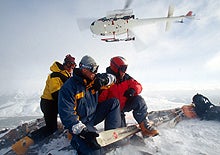Sun Valley Heli-Ski, ID

Max Elevation:
12,078 feet
Max Vertical Drop:
3,300 feet
Average Vertical Logged Per Day:
12,000 feet
Price:
$675 for 6 runs; $80 per extra run
Getting There:
Meet at Sun Valley Heli-Ski’s office in downtown Ketchum, Idaho.
Info:
800-872-3108; sunvalleyheliski.com
Beta:
Just as Sun Valley ski area was America’s first destination ski resort, so is Sun Valley Heli-Ski (founded in 1966) our nation’s first rotor-blade operation. But the heli-ski terrain still feels as new as morning freshies after an overnight dump. Groups move fast and efficiently, flying in shiny, high-powered A-Star 350B2 helicopters and descending in commando units with a guest-to-guide ratio of four to one.
Much of SVHS’s 750-square-mile permit area lies west of Sun Valley, encompassing three ranges in the Sawtooth National Recreation Area: the Boulder, Pioneer, and Smoky Mountains. The most commonly skied terrain is in the Smokies, just a short (and therefore less expensive) flight from the Highway 75 staging zone. The permit area is immense, especially in a region that’s been explored by skiers for decades.
The perfect fall lines of Sun Valley’s Baldy Mountain—wide-open, continuous vertical drops of 2,000-plus feet—are mirrored in the heli-served backcountry, but without the people or the grooming machines. During my visit last spring, my group (an experienced, turn-hungry family from Connecticut) and I notched run after run on silky, hero-making corn. I suppose we would have traded it for the thigh-deep, cold-smoke powder you can get in winter. But at the time, we certainly didn’t mind the unpeopled Idaho landscapes, spring conditions, and safe, sun-splashed snow. Which explains why operations like SVHS can thrive for four decades, and why people save their paychecks for years to visit.
Snowpack
SVHS rarely struggles to find skiable snow, due to the seemingly infinite lines and aspects in its permit area. Even in dry years, owner and lead guide Mark Baumgardner claims SVHS’s western terrain gets 30 percent more snow on average than the Ketchum area. “Cool temps make for quality snow, says Baumgardner. “Still, the snowpack can be variable into April. (avalanche.org/~svavctr)
Terrain Highlights
Most of the skiing takes place in the 7,000- to 10,000-foot range below timberline. But don’t get hung up on the “timber part: The sunnier slopes here are festooned with sage and the occasional conifer, but you’d never consider them obstacles. Enjoy 33-degree pitches and steady 2,000-vertical-foot shots on runs like Bufus and Bowl of Roaches. At 40 degrees, the Upper Chutes are the steepest—SVHS opens them only to advanced skiers, and only when conditions are stable.
Weather
With 280 days of sunshine per year, chances are good the heli can fly. Unlike the maritime-trending Panhandle, this part of Idaho enjoys a more continental climate, which means the snow is drier. It usually recrystallizes into a soft layer known as surface hoar. If you’d rather not pay for some ho’, visit during January and February, the snowiest months.
The Guides
While SVHS employed Sun Valley ski instructors in the early days, the heli outfit has been a bona fide guide service since 1976, and now the lead guides have at least 10 years of experience.
The Lodge
Heli-ski customers aren’t required to stay at the three-year-old Smoky Mountain Lodge, but those who do (it sleeps eight) enjoy a professional chef and unrivaled solitude in their own private valley. With huge windows and sweeping views, it’s the only fly-in heli-ski lodge in the Lower 48.
The Chow
Grab a coffee and biscotti at Java on Fourth before meeting your guide. Lunch is a ham, turkey, or veggie sub—washed down with hot tea—served between runs.
Bang for Buck
Skiing/lodging/dining packages at the Smoky Mountain Lodge aren’t cheap: They start at $$3,225 per person for three days of unlimited skiing and two nights lodging. But less expensive alternatives exist: Buy a “one-lift heli-drop for $275, and SVHS will fly you to a backcountry summit to tour the outback however you wish.
Must-Know
A more unique—and cheaper— lodging option is SVHS’s backcountry yurt. Situated in the Pioneer Mountains, it has a sauna and costs only $30/person a night.